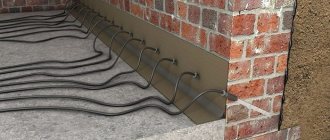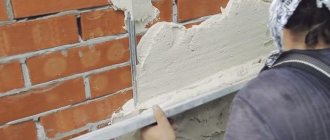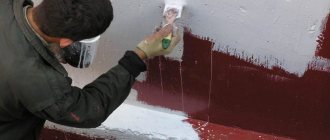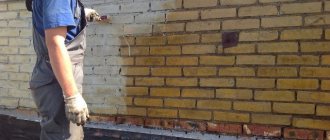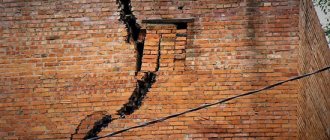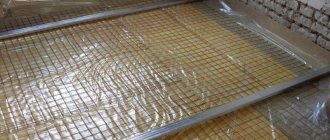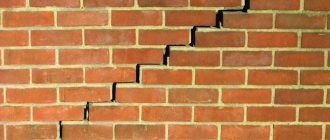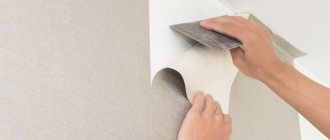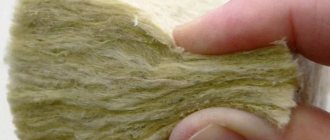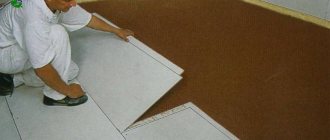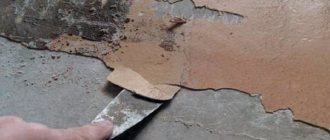Brick is the most popular building material due to its high strength and fairly low cost. But at the same time, it has such a property as porosity. Moisture in the air or foundation is well absorbed into the material and rises to a considerable height, right up to the roof. To prevent this, the walls of the house are waterproofed if they are made of brickwork.
This process makes it possible to significantly increase the period of use of the coating and prevent the occurrence of mold. Most often, experienced builders prefer a material such as penetrating waterproofing. The finished mixture with active components fills all existing cavities, and upon contact with water, the crystals increase, giving the coating hydrophobic qualities. Such waterproofing of bricks from the outside, both the basement and the walls, is carried out in several stages, starting with preparing the surface for further processing.
Why waterproof brickwork?
A process such as waterproofing a building under construction is a mandatory stage, this is especially important when reliable protection from precipitation or groundwater and melt water is needed for the brickwork of the foundation. Since these structures bear the maximum load from the house itself, as well as from the negative influence of the external environment. Snow, melt water or rain penetrates the porous structure of the brickwork, gradually destroying the structure. Therefore, it is necessary to properly cut off the movement of moisture in the walls of the house. This work is carried out at the junction of the basement and walls, but waterproofing can be enhanced by treating it with special compounds indoors. An integrated approach makes it possible to combat destruction throughout the entire period of operation of the house.
Depending on what type of protection was chosen, the process of carrying out the work may be different. For example, waterproofing bricks from the outside is often carried out using penetrating compounds or (if we are talking about a base or foundation), then welded materials. This is also done using a plaster mixture based on lime-cement mortar or a ready-made composition, which includes components that protect against moisture.
Professional builders consider brick waterproofing to be one of the most important processes; if neglected, water will penetrate into the building material, thereby causing severe damage to the structure. As a result, this leads to premature wear of the house, brittleness of the brick, and corrosion of the reinforcement.
What does it represent?
It has another name - silicate glue, because it is an aqueous solution of silicate salts. There are 2 main types depending on the main component:
- sodium;
- potassium
The substance, due to its chemical composition, has the ability to perfectly fill porous materials.
In its pure form, liquid glass is crystals, white or colorless. In practice, an aqueous solution is used with the consistency of a viscous mass that quickly hardens due to a reaction with carbon dioxide. In construction work, self-made solutions are used based on silicate glue with the addition of water, sand and cement.
Negative and positive sides
The material has many advantages. These include:
This material is considered inexpensive and effective.
- strong adhesion to the surface;
- excellent penetrating ability;
- high moisture resistance;
- low thermal conductivity;
- passivity to most chemicals;
- good anti-corrosion qualities;
- non-toxic;
- antistatic properties;
- low consumption (especially when creating cement mortars;
- low cost.
However, it also has its drawbacks:
- Liquid glass coating cannot be painted or varnished on top.
- The material is quite fragile and susceptible to destruction as a result of mechanical stress.
- To increase the service life, it needs to be combined with other types of waterproofing.
Return to contents
How does it work?
In its basic form it is almost never used during construction work. The following mixtures are prepared on the basis of silicate glue:
| Type of solution | Compound | Application |
| Primer | Cement and silicate glue 1:1, water to give the desired consistency | Intermediate treatment of bases |
| Waterproofing | Sand, liquid glass, cement in equal parts | Creating a moisture barrier |
| Refractory | Sand, cement and silicate glue 3:1:1) for cement floor screed or a separate aqueous solution | Fireproof coating |
| Antiseptic | Liquid glass and water 1:1 | Fungus removal and prevention |
| Strength Improvement Compound | 0.4 kg silicate glue, 1 liter of water | Strengthening the foundations |
| Concrete hydrophobic mortar | A glass of liquid glass and 10 liters of clean water with the addition of dry concrete | Giving concrete waterproofing properties |
Benefits of using penetrating waterproofing
Such an innovative product as penetrating waterproofing is becoming the most popular method of protective treatment of brickwork, as it has the following advantages.
The composition is suitable for different types of buildings, both for external treatment and inside the building, which is very convenient.
- Increases the resistance of building materials to chemicals.
- Good quality penetrating waterproofing for bricks is environmentally friendly and non-toxic to humans.
- The layer formed when the penetrating waterproofing hardens has no seams or joints, which does not give moisture a chance to get inside the structure.
- Waterproofing of this type is a reliable means of protecting the metal components of a building structure from corrosion.
- The walls, after waterproofing has been carried out, do not need subsequent priming before finishing the brick.
Waterproofing brickwork with a penetrating composition is a highly effective protection, since the special interaction of the components of the composition and the surface being treated leads to the filling of pores and an increase in the hydrophobicity of the walls or foundation.
Briefly about the main thing
Water-repellent compounds are used to protect building materials from the negative effects of water and moisture penetration.
Hydrophobic agents additionally help improve the frost resistance of the base, strength and extend the service life of structures.
The products also, when used correctly, do not have a negative impact on the overall quality of the brickwork; vapor permeability and breathability are maintained.
The main classification of water repellents is based on composition and methods of application.
In terms of composition, silane siloxanes are considered the best, among which there are decorative impregnations with a wet stone effect.
Three types of materials are distinguished by application: for adding to the working solution for preparing blocks or concrete, for surface treatment with different abilities relative to the depth of penetration, for injection to strengthen structures in the presence of microcracks and other damage.
The maximum effect of water repellents can be achieved with comprehensive protection of bricks using three types of agents at once.
Ratings 0
Stages of work
Waterproofing a construction site with a penetrating mixture can be carried out both during the construction of the building and during major repairs or even during operation. When applying the composition, crystals form in the pores of the brick, thanks to which the ingress of water is reduced to zero.
Waterproofing bricks is carried out in several steps.
Careful preparation of walls, which are cleaned from oil stains, plaster, old paint, dust and dirt, in order to increase the penetrating ability of the composition. If there is mold, then before starting work, an antiseptic is applied to the walls.
- Along the entire brick wall, specially shaped recesses are made at an angle of 45 degrees to the surface. Similar holes are made at a distance of 5 centimeters.
- The recesses made in the wall are washed with water, as a rule, this is done using a high-pressure apparatus, and then filled with a penetrating composition.
- Sealant is applied to the points where communication pipes enter.
- The next stage is applying the composition to the walls (waterproofing masonry) using a brush.
When waterproofing bricks, you need to remember that you need to take a set of measures to protect the construction site from moisture. For example, if you do not protect the foundation, then treating walls with penetrating compounds will not achieve 100% reliability. Therefore, these works should be carried out by specialists, from design to complete completion of the process.
Waterproofing a brick plinth wall
As we mentioned above, the choice of material, type and method of waterproofing a brick plinth depends on where the waterproofing work will be carried out, from the inside or outside. If work is carried out from the inside of the base, then it is better to protect the entire foundation with two-component polymer-cement waterproofing. If we are talking about active leaks, then a set of measures is recommended:
- Caulking of seams between masonry with non-shrinking sealants;
- Preparing and cleaning the surface from dust and dirt;
- Injection device for eliminating active leaks in a brick wall, repairing damaged seams and cracks in bricks;
- Construction of a two-component polymer-cement membrane to protect the base and foundation from further leaks and the appearance of damp spots that contribute to the formation of fungus and mold
You can read more about waterproofing walls in the article - “Waterproofing basement and house walls from the outside and inside - Methods, materials, prices and technology.”
Types of waterproofing
Waterproofing masonry can be done in two ways, each of which depends on the type of structure.
- Waterproofing performed on the outside of brickwork. This method is applicable to all types of foundations, basements and basements.
- Internal waterproofing. It is carried out when there is a need to protect an already constructed building, finished with finishing bricks, tiles, or a plastered facade.
When choosing penetrating waterproofing for brickwork, it is important to take into account such points as the purpose of the building, the type of brick, the climate in the area, the amount of precipitation, the type of foundation, and the level of groundwater.
Common waterproofing materials
Today, the building materials market offers a large number of penetrating compounds that can be used to effectively waterproof masonry. Let's consider the highest quality and most popular brands.
- HydroPaz Prime + Acryl is a sealant produced by the domestic manufacturer Hydro, which is the official representative of the famous German brand. A two-component cement-polymer mixture is characterized by high penetrating ability, elasticity, and excellent adhesion to all types of building materials. In addition, the composition contains anti-corrosion additives.
- “Xypex” is a Canadian-made waterproofing product that contains active additives that prevent moisture from entering the pores of the material and the subsequent destruction of the brick from chlorides and other chemical compounds.
- “Penetron” - this material contains several grades of cement, a number of active components and quartz sand. As a result of applying such a mixture, high-quality penetrating waterproofing of brickwork is achieved, provided that the maximum size of defects in the wall does not exceed 0.4 mm. This material is environmentally friendly, it is harmless to humans and the environment.
- “Waterplug” is a mixture of dry components (aluminate cement, sand and additives). The composition is designed for fast and high-quality penetrating waterproofing; it sets quite quickly, and can also eliminate pressure leaks in a matter of time. It is used not only as waterproofing of bricks on the outside, but also as protection for water supply systems.
- WDM SM-Extra is a professional waterproofing designed for treating brick and concrete structures. When dried, it forms a waterproof layer that is resistant to chemicals and has the ability to “self-heal” cracks in the wall. Waterproofing bricks with this composition implies that the mixture gets into the pores, filling them, but, nevertheless, the building material continues to “breathe.”
The most common penetrating materials for protecting a brick wall
If deep penetration waterproofing is used, the surface will become insensitive not only to water, but also to the influence of solvents, petroleum products and alkali. The construction market is full of products that protect brick walls. Here is a list of the most common ones:
- "Khureh." Made in Canada. Waterproofing is based on cement. It has active additives. Thanks to them, water will not penetrate into the structure of the material. In addition, they perform a protective function, since the wall becomes invulnerable to the effects of chlorides and corrosion. The principle of operation is simple: active additives pass into the pores, after which an insoluble compound is created. When the substance comes into contact with water, a crystalline structure is formed. Such compounds in the concrete mixture make it absolutely protected from external influences and moisture.
- Isomat Aquamat. Representative of coating-type waterproofing products that penetrate the structure. Most often used as a protective layer against water in swimming pools, wells and other similar structures. Product advantages: the composition is constantly in active condition after use, surfaces receive maximum moisture protection, structural elements are less vulnerable to mechanical damage, and the fittings are not afraid of corrosion. The product can be used in structures and containers used to supply drinking water.
- "Penetron". The product is made on the basis of quartz sand and cement (a special brand is used). Additionally, the raw materials are mixed with active substances. The product is intended for waterproofing work on reinforced concrete and other materials that have cracks no more than 0.4 mm wide. Penetron is also used to process brickwork, plaster and concrete structures made from a sand-cement mixture. The substance is applied both from the outside of the walls of the house and from the inside. It is environmentally friendly, it can be applied with a brush even on a damp surface; after crystallization, moisture will not penetrate up to 1 m deep.
- "Virtyoz". Penetrating type waterproofing for treating walls inside and outside. The packaging contains cooking instructions. This is a kind of waterproofing plaster, which, after mixing, is applied with a spatula or brush to the brickwork or concrete surface. After application, it is recommended to moisturize the surface for 3 days.
- "Waterplug." This is a dry mixture consisting of aluminate cement, quartz sand and active additives. With its help, it is easy to eliminate pressure leaks that form in concrete or brick structures. Feature: quick setting, ability to expand. The material is used together with Penetron. The product is environmentally friendly and therefore suitable for structures that provide water supply.
To summarize, we can say that waterproofing bricks with deep penetration means has a lot of advantages. They are affordable, easy to use, environmentally friendly and, most importantly, can be used on an already erected structure. The brick surface and masonry will be reliably protected, and the penetrating properties allow the products to be used even on double silicate bricks.
Important! It should be borne in mind that such waterproofing is universal and will help achieve complete protection. If it copes with the walls, then it is better to additionally protect the foundation with horizontal insulation. For maximum effect.
Horizontal waterproofing device
In a situation where the house is still under construction, only the foundation or basement has been built, waterproofing can be carried out in the simplest way - by installing horizontal insulation.
For such events, traditional materials such as roofing felt, all kinds of bitumen-based compositions and penetrating mixtures are suitable. To achieve maximum effect, it is recommended to carry out a set of protective manipulations to treat the foundation before laying brickwork.
Of course, there are methods that allow horizontal waterproofing in a finished building:
- injection - hydrophobic polymer mixtures are fed into the created cavities through packers under pressure;
- the so-called cutting of the wall and laying sheets of roofing material in the resulting cavities or coating with mastic.
Considering that such work presents certain difficulties, its cost is significantly higher than waterproofing at the construction stage. Therefore, it is necessary to carry out procedures in advance to protect the building from moisture.
Penetrating waterproofing
This type of brick waterproofing is a fairly new method of dealing with excess moisture, but it has already proven itself to be one of the most effective. Specially selected components of the compositions penetrate micropores, where, upon contact with water, they harden, crystallize, increase in size and completely fill the available space. This ensures high tightness of the structure and completely blocks access to water.
Of course, when performing penetrating waterproofing of a building, you will have to spend more money than on treatment with coating compounds or laying rolled materials. But, on the other hand, it is worth considering the fact that this type of moisture protection can be used both outside and inside the building. In addition, the resulting layer is not afraid of mechanical damage and chemicals contained in groundwater and melt water.
Application area
Penetrating waterproofing can be used indoors.
Penetrating mixtures are used wherever protection of concrete structures from moisture is required: sewage and groundwater, sea water, etc. This protection has proven itself in various areas of construction. The chemicals that make up dry mixtures are safe for human health, which is why they are widely used for waterproofing wells, drinking water tanks, swimming pools, and bathrooms.
The mixtures are effective when used even from inside buildings. For example, penetrating basement waterproofing is effective for protecting against groundwater, even without additional application to the foundation walls. This reduces the cost and duration of repair work, because the foundation does not need to be dug up and thoroughly dried, as is done in the case of using roll and mastic waterproofing systems.
The non-toxicity of the mixtures allows them to be used in residential areas: in the bathroom to protect walls and floors from the harmful effects of moisture, in residential areas of the basement, and so on.
Types of waterproofing for formwork
Important! Any finishing work should be postponed while the crystallization process takes place. Any type of plaster, including gypsum, or other decorative finishing materials can be applied to a surface treated with waterproofing compounds no earlier than after 30 days.
If you do not wait the required time before starting finishing work, the finishing will be hopelessly damaged.
Wall treatment outside and inside
Considering that water penetrates not only from the soil, but also from the air, proper waterproofing of walls from outside to inside is needed. Otherwise, the building is at risk of dampness, constant condensation, and mold.
The choice of waterproofing material largely depends on what kind of finishing the facade of the house will be. If we are talking about a ventilated facade, then in this case a waterproofing membrane is used, mounted directly on the insulation. In the case where a brick façade is planned, the ideal option would be to apply penetrating waterproofing to prevent moisture from penetrating into the brick.
If the building has already been built, a ventilated facade has been made, and the issue of waterproofing has not been resolved, then the only option will be treatment inside the building, using roofing felt or glass insulation for basements and mastics for residential premises.
Air humidity
I bought a country house made of sand-lime brick: half a brick/air gap/half a brick/plaster. There is a garage attached to the house on the north side under one roof. It is clear that the walls have poor thermal conductivity characteristics. But. The concern is not so much about the issue of heat preservation (the country house is not used in winter) as about air humidity. In one of the rooms, the humidity in the summer is so high that the floors do not dry after wet cleaning, and in the spring it is terribly cold in this room. In addition to the stove, we are trying to warm it up with UFO heaters. This room has a window to the west, one wall adjoins the garage. The problem is that there are traces of mold along the entire length of this wall, from bottom to top and where there is more furniture, the larger and higher the areas. And a short patch of mold down from the corner on the west wall. Other rooms do not have such obvious problems, namely: the corner room (to the west and south) - a very small area of mold above the baseboard under the west window, but the humidity is slightly increased; eastern - no problem at all. The garage is sheathed 1 cm. plywood. The second floor is warm and dry.
Explain what the problem is with the wall adjacent to the garage and how to solve this problem on a low budget? If the reason is the lack of ventilation between the walls of the air space, how best to design it (under the roof, outside, in what places)?
PS The situation with the problem described above is getting more complicated. Yesterday I opened up the plywood sheathing in the garage on the wall adjacent to the house. 2 cm is tightly laid under it. polystyrene foam, plywood seams are carefully puttied and the sheathing is painted. If we follow your article “Wall made of sand-lime brick. Thermal insulation with foam plastic on the outside”, the wall on the inside (of the house) especially should not get wet. But it’s already July, the room is constantly ventilated, but the humidity is still high and the wall feels damp to the touch. The garage, on the contrary, is dry.
Author: Dmitry Belkin
The problem you are facing is so complex that an accurate diagnosis can only be made by conducting field research. In this answer, I can only give a list of possible reasons for this situation, and only those that I could think of.
Firstly, the properties of sand-lime brick as a building material. This is a very inconvenient building material. It is absolutely not breathable. The only thing that could be worse is reinforced concrete. Excess moisture should be absorbed into the walls and not flow down them. Sand-lime brick does not have such properties. This is a non-breathable material. I don’t know who invented it, but it certainly doesn’t deserve a monument. However, your problem seems to be not only this.
Let's think logically. The walls become wet and covered with mold, which means you need to look for a source of water. Water may appear on the walls.
- As condensate in this case, it is necessary to work on the thermal insulation of the walls. It looks like this is not your case, since we are talking about the summer months.
- Getting wet due to precipitation. It is necessary to check the condition of the roof and identify ways of getting the wall wet. This is also unlikely to be your case. The bottom of your walls gets wet and the floor doesn’t dry.
- The floor and wall may become wet due to soil moisture. Maybe your soil is too close to the floor? Maybe the underground is not ventilated? The plinth must have vents (small holes) on opposite walls of the plinth. These vents should be enough to create a draft in the underground. It is quite possible that it is under the wet wall that there is a vein of water. In this case, it is necessary to drain water from the foundation and increase ventilation of the subfloor. If there are no puddles in the underground but the ground is damp, you can use forced exhaust ventilation. Wetting of walls through the foundation in most cases occurs due to gross construction errors. If this is so, then other than increased ventilation there are no methods left to combat wetting. Do not break the wall to install waterproofing. My intuition tells me that this is precisely your problem.
That's all I can say about your problem. Sorry it's small and vague. Dmitry Belkin
Protection of the foundation and basement
Undoubtedly, impregnation of load-bearing structures with penetrating waterproofing is a fairly effective measure, but it may be useless in a situation where the foundation has not been treated and the brick has not been waterproofed from the outside. Since water and the aggressive substances it contains will cause rapid destruction of the brick structure, which in turn will lead to the occurrence of cracks and other defects in the walls.
The inner surface of the basement can be treated at any stage of construction, as well as during the operation of the building. From the outside, this can be done at the construction stage, when the base of the foundation is insulated using rolled materials. If it is necessary to waterproof a built house, then this is done in several stages - from removing the soil layer to treating with coating compounds and laying roofing material. Another method in this case is injection, as the most effective.
The choice of protection method in this situation largely depends on the type of foundation, the depth of groundwater, the degree of aggressiveness of the environment, and the characteristics of the soil. The waterproofing market is saturated with a variety of compounds, mastics, and membranes that can be combined to carry out a set of measures to protect a structure from moisture.
All work - from choosing waterproofing to execution - must be entrusted to specialists, since process violations and illiterate actions can lead to dire consequences. If you do this according to all the rules, then the house will serve for a long time, without requiring frequent repairs, and living in it will always be comfortable.
Finishing with protective agents
When constructing any building, it is necessary to waterproof the foundation, walls, basement and basement. Only in this case will the building be resistant to moisture and not collapse after a short time. To ensure effective protection, you need to use high-quality products, and the process itself must be carried out in full accordance with technology, processing all elements without omissions.
Penetrating waterproofing is applied to the brickwork using a brush or roller.
It is important to note that some materials, characterized by high strength, reliability and durability, lose all properties when exposed to water and deteriorate very quickly. Brick has these properties. Therefore, penetrating waterproofing is the best option for preserving masonry.
The best thing is to provide for the laying of protective material at the construction stage. In this case, the most effective protection will be provided. Especially considering that moisture can come from the foundation.
In some cases, the base of the building can also be built from brick. In this case, the same methods of protecting the foundation from groundwater and wastewater and the same materials are used. Then the strength and reliability of the foundation will remain for many years.
